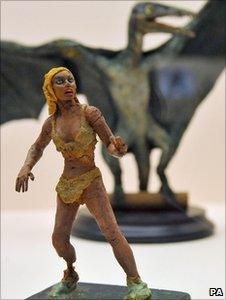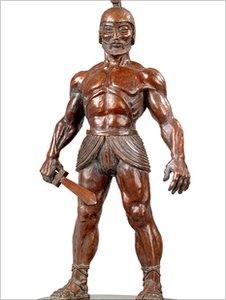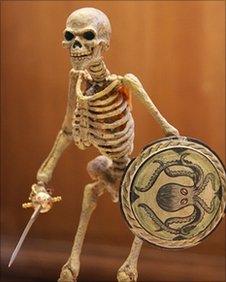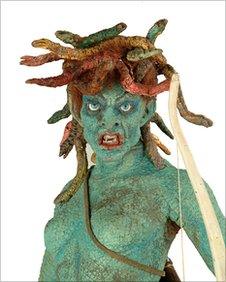Ray Harryhausen's classic creatures
- Published
.jpg)
Ray Harryhausen's Medusa appeared in his last feature Clash of the Titans
Ray Harryhausen's fantastical creatures have inspired generations of movie makers.
"I've worshipped him since I was a kid," says Oscar-winning animator Nick Park, of Wallace and Gromit fame.
Harryhausen, who turns 90 this week, made his models by hand and shot them frame by frame to create some of cinema's best-known battle sequences.
One of his classic scenes is the skeleton sword fight in 1963's Jason and the Argonauts.

The exhibition includes a tiny model of Raquel Welch from the film One Million Years BC
His other films include The Seventh Voyage of Sinbad (1959), One Million Years BC (1966), The Golden Voyage of Sinbad (1973) and his last feature Clash of the Titans (1981).
They are a world away from the CGI and 3D effects of modern cinema, but Harryhausen is cited by the likes of George Lucas, Steven Spielberg, James Cameron and Peter Jackson as an inspiration.
To mark his birthday, an exhibition of Harryhausen's stop-motion work opens on 29 June at the London Film Museum. It includes original models, bronze casts and artwork.
Aardman animator Nick Park was inspired to make his first model after seeing Harryhausen demonstrate one of his dinosaurs on TV.
"I couldn't believe that someone had brought dinosaurs to life - it was a magical moment for me," he says.
"I went off and built a brontosaurus out of coathangers and covered it with foam rubber and stretched a pair of my mum's old tights over them for skin. I filmed it walking across my bedroom floor."
Here Nick Park picks his three favourite Ray Harryhausen movie moments.
TALOS - JASON AND THE ARGONAUTS (1963)

Hercules and Hylas enter a valley containing statues of the gods. They enter a vault beneath a towering bronze colossus called Talos. After the men steal some treasure, the statue comes to life...
"I saw it on TV when I was about 11. I remember the moment when the statue comes to life.
The head of Talos just turns slowly. It's all very eerie. It's one of those moments where less is more - small things are very dramatic.
The Argonauts try to make it back to the ship and Talos cuts them off and picks up the boat and shakes them all out of it.
I've seen the original Talos model - and was amazed how small it was."
WARRIOR SKELETONS - JASON AND THE ARGONAUTS (1963)

Seven sword-wielding skeletons sprout from the ground and battle Jason and his men in a classic four-minute action sequence.
"He did it all - he storyboarded it, shot the background plates, made the models in his kitchen and shot the whole thing himself.
Each skeleton has several different components, so it was a challenge to be moving so many limbs on seven skeletons.
And this was in the days when you didn't have any way of monitoring each movement. Today you can check each frame as you do it and adjust it.
He was working blind really - you only see it when the film comes back from the lab. I think he was averaging something like a second and a half a day.
I know animation is slow but that is slow - at Aardman we're averaging two and a half seconds per animator so we're rocketing."
MEDUSA - CLASH OF THE TITANS (1981)

Perseus enters the lair of the snake-haired Medusa, who picks off one of his men with an arrow and turns another to stone with her eyes. Perseus uses his reflection to trick her - and chops off her head.
"It was so well done and frightening. It's all the same technique but going to different heights of intricacy.
I thought it was a combination of really good lighting and shadow. I do admire a lot of CGI, but there's something not real about it.
In the Medusa that Ray did it's there and it's grounded - there's real light hitting real surfaces. Somehow your brain knows it's not real with CGI."
Ray Harryhausen - Myths and Legends opens at the London Film Museum on Tuesday 29 June. Clash of the Titans and The Golden Voyage of Sinbad are being screened at Bafta in Piccadilly on Saturday 10 July.